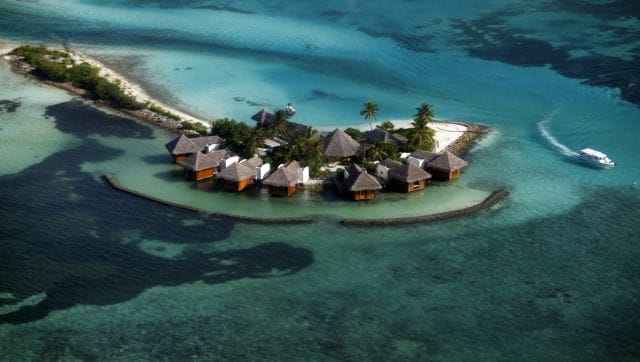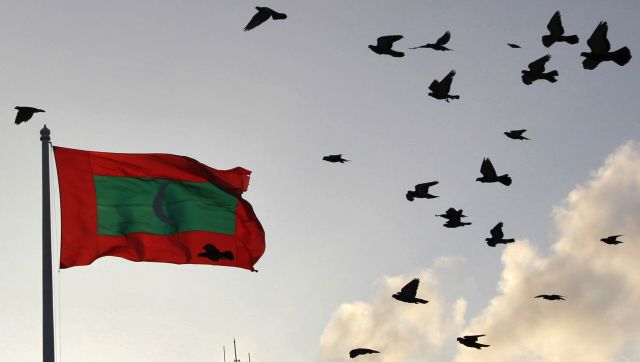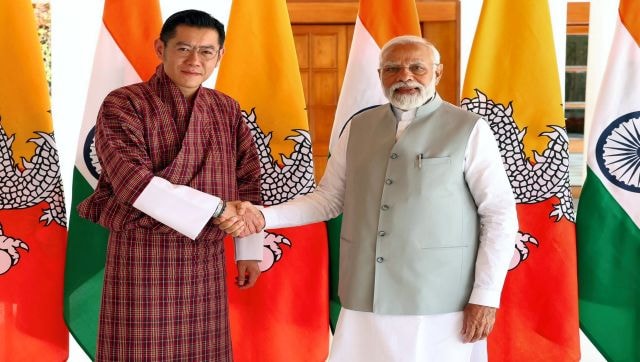Ties between India and the Maldives have been souring over the past few months. Amid this deterioration of ties and the recent diplomatic spat, comes another bummer for the neighbouring island country. After Finance Minister Nirmala Sitharaman presented the interim Budget in Parliament, papers revealed that the Centre has reduced its development assistance to Male in the next financial year. We take a closer look at New Delhi’s funding to the Maldives, as well as which other countries are recipients of India. India as a donor India has been a constant donor of funds to neighbouring countries — a move that can be traced back to the 1950s and 1960s. In those days, India’s aid programme was small and focused on building local capacities. However, in recent times there has been a change, and New Delhi is today viewed as an emerging and important donor. For instance,
Afghanistan’s parliament building
is funded by India. In 2015, Prime Minister Narendra Modi announced $600 million in assistance for development projects in Africa at an India-Africa Forum Summit attended by 50 African nations. An EPW report says that to a certain extent India’s benevolence is inspired by competition with China, which has used aid effectively to secure oil interests in Africa and Asia. India’s aid to the Maldives But just how much has India allocated as aid to Maldives? Data reveals that Male has been a regular recipient of India’s foreign aid. Last year’s initial budget estimate for assistance to Male was Rs 400 crore. However, it ended up spending Rs 770 crore, per the revised estimates. The interim Budget papers reveal that India’s development assistance to the Maldives this year has been pegged at Rs 600 crore. At first glance, it shows a bump in aid. However, if you take into factor how much New Delhi actually donated, it reveals a cut of 22 per cent. [caption id=“attachment_13681052” align=“alignnone” width=“640”] An aerial view shows a resort island at the Male Atoll. India has been granting assistance to the island nation for a long time. In FY24, 6.84 per cent of the overall allocation for aid to foreign countries has gone to the Maldives. File image/Reuters[/caption] India’s grants to the Maldives has been rising for a few years now, until now. A look at the data shows that in 2018, the island nation received 2.1 per cent of the total grants and loans that India was giving out. This increased to a whopping 6.8 per cent in the following year. And in FY24, 6.84 per cent of the overall allocation for aid to foreign countries has gone to the Maldives. This cut in India’s development assistance comes amid the decline of ties between the two nations. This has largely been driven by the
India Out campaign
that has been carried out in Male of which President Mohamed Muizzu is a big proponent. In fact, during his campaigning, he had pushed for this quite actively. Later in January this year, Indians began ditching the island country after three leaders in President Mohamed Muizzu’s Cabinet made
derogatory comments
about Prime Minister Narendra Modi and India. [caption id=“attachment_13681082” align=“alignnone” width=“640”]
An aerial view shows a resort island at the Male Atoll. India has been granting assistance to the island nation for a long time. In FY24, 6.84 per cent of the overall allocation for aid to foreign countries has gone to the Maldives. File image/Reuters[/caption] India’s grants to the Maldives has been rising for a few years now, until now. A look at the data shows that in 2018, the island nation received 2.1 per cent of the total grants and loans that India was giving out. This increased to a whopping 6.8 per cent in the following year. And in FY24, 6.84 per cent of the overall allocation for aid to foreign countries has gone to the Maldives. This cut in India’s development assistance comes amid the decline of ties between the two nations. This has largely been driven by the
India Out campaign
that has been carried out in Male of which President Mohamed Muizzu is a big proponent. In fact, during his campaigning, he had pushed for this quite actively. Later in January this year, Indians began ditching the island country after three leaders in President Mohamed Muizzu’s Cabinet made
derogatory comments
about Prime Minister Narendra Modi and India. [caption id=“attachment_13681082” align=“alignnone” width=“640”] A Maldives national flag flutters as pigeons fly past during the morning in Male. An India Out campaign in the island country has led to a deterioration of ties between the two countries. File image/Reuters[/caption] Moreover, Muizzu’s visit to China after his election was also viewed as giving a signal of intent on how he plans to treat the Maldives’ ties with India. During his visit to Beijing, Muizzu had urged Chinese to visit his country, saying: “China was our (Maldives’) number one market pre-COVID, and it is my request that we intensify efforts for China to regain this position.” Notably, it seems China has obliged, as
Maldivian tourism data
showed that tourists from the Asian giant have increased in January this year, while those from India have reduced. Muizzu has also called for the exit of Indian troops in the island country and given them a deadline of 15 March. Other nations receiving India’s grants But it’s not just the Maldives that receives developmental assistance from India. Countries such as Nepal, Bhutan, Afghanistan and Myanmar among others all receive grants from India. In fact, data reveals that
Bhutan
is the leading recipient of Indian government grants and loans, with an allocation of Rs 2,068 crore. The development outlay for the Himalayan nation in 2023-24 was Rs 2,400 crore. This year, India has also reduced its grant to Bangladesh by Rs 10 crore from Rs 130 crore in Budget 23-24 (revised estimate). India has also cut assistance to Myanmar; under Budget 2024, India has allocated Rs 250 crore in grants to Myanmar compared to Rs 370 crore last year. [caption id=“attachment_13681112” align=“alignnone” width=“640”]
A Maldives national flag flutters as pigeons fly past during the morning in Male. An India Out campaign in the island country has led to a deterioration of ties between the two countries. File image/Reuters[/caption] Moreover, Muizzu’s visit to China after his election was also viewed as giving a signal of intent on how he plans to treat the Maldives’ ties with India. During his visit to Beijing, Muizzu had urged Chinese to visit his country, saying: “China was our (Maldives’) number one market pre-COVID, and it is my request that we intensify efforts for China to regain this position.” Notably, it seems China has obliged, as
Maldivian tourism data
showed that tourists from the Asian giant have increased in January this year, while those from India have reduced. Muizzu has also called for the exit of Indian troops in the island country and given them a deadline of 15 March. Other nations receiving India’s grants But it’s not just the Maldives that receives developmental assistance from India. Countries such as Nepal, Bhutan, Afghanistan and Myanmar among others all receive grants from India. In fact, data reveals that
Bhutan
is the leading recipient of Indian government grants and loans, with an allocation of Rs 2,068 crore. The development outlay for the Himalayan nation in 2023-24 was Rs 2,400 crore. This year, India has also reduced its grant to Bangladesh by Rs 10 crore from Rs 130 crore in Budget 23-24 (revised estimate). India has also cut assistance to Myanmar; under Budget 2024, India has allocated Rs 250 crore in grants to Myanmar compared to Rs 370 crore last year. [caption id=“attachment_13681112” align=“alignnone” width=“640”] Bhutan has emerged as the leading recipient of Indian government grants and loans, as outlined in the Union Budget documents. File image/PTI[/caption] On the other hand, Nepal saw a slight increase — from Rs 650 crore last year (revised estimate) to Rs 700 crore this year — and so did African countries, from Rs 180 crore last year (revised estimate) to Rs 200 crore. And keeping its special relationship with Afghanistan in mind, it has allocated Rs 200 crore for the neighbouring country. Other countries like Mongolia, Sri Lanka, Seychelles and Mauritius have also been allocated grants and funds as per the Budget documents. It’s important to note that this year, India has cut its total allocation of aid to countries by 10 per cent — from Rs 5,426 crore in the revised estimates for 2023-24 to Rs 4,883 crore in this year’s Budget. With inputs from agencies
Bhutan has emerged as the leading recipient of Indian government grants and loans, as outlined in the Union Budget documents. File image/PTI[/caption] On the other hand, Nepal saw a slight increase — from Rs 650 crore last year (revised estimate) to Rs 700 crore this year — and so did African countries, from Rs 180 crore last year (revised estimate) to Rs 200 crore. And keeping its special relationship with Afghanistan in mind, it has allocated Rs 200 crore for the neighbouring country. Other countries like Mongolia, Sri Lanka, Seychelles and Mauritius have also been allocated grants and funds as per the Budget documents. It’s important to note that this year, India has cut its total allocation of aid to countries by 10 per cent — from Rs 5,426 crore in the revised estimates for 2023-24 to Rs 4,883 crore in this year’s Budget. With inputs from agencies
Has India reduced financial aid to the Maldives amid the ongoing spat?
FP Explainers
• February 2, 2024, 10:26:54 IST
India’s development aid to the Maldives has gone from last year’s Rs 400 crore to Rs 600 crore, as per the interim Budget papers. However, revised estimates reveal that New Delhi ended up spending Rs 770 crore on the island country. This drop in funding comes when bilateral ties have turned rocky
Advertisement
)
End of Article